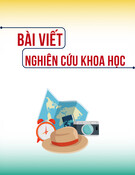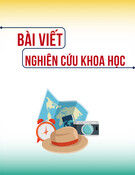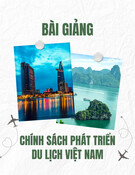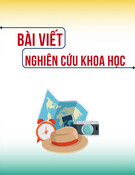
Ho Su Minh Tai / Tạp chí Khoa học và Công nghệ Đại học Duy Tân 03(64) (2024) 40-51
40
Gastronomy tourism: Opportunities and challenges for Vietnam,
especially Da Nang city
Du lịch ẩm thực: Cơ hội và thách thức nhìn từ Việt Nam,
đặc biệt tại thành phố Đà Nẵng
Ho Su Minh Tai*
Hồ Sử Minh Tài*
Faculty of International Hotel & Restaurant management, Hospitality and Tourism Institute, Duy Tan University,
Danang, 550000, Vietnam
Khoa Khách sạn & Nhà hàng Quốc tế, Trường Du lịch, Trường Đại học Duy Tân, Đà Nẵng, Việt Nam
(Date of receiving article: 05/01/2024, date of completion of review: 21/03/2024, date of acceptance for posting:
06/05/2024)
Abstract
Food plays an important role in the tourism industry. Food-related activities not only attract tourists but also help bring
many development opportunities to the local community. Therefore, among many types of tourism, gastronomic tourism
has become a type that takes special consideration for development in numerous destinations. However, successfully
developing this type of tourism to become a true gastronomic destination has many challenges. Based on the analysis of
secondary data sources, this article discusses some issues related to gastronomy tourism, synthesizes experiences and
initiatives from successful destinations, and analyzes opportunities and challenges related to gastronomy tourism
development in Vietnam, especially in Danang city, contributing to proposing ideas for this type of tourism.
Keywords: gastronomy; gastronomy tourism; food tourism; Danang, Vietnam.
Tóm tắt
Ẩm thực đóng một vai trò quan trọng trong ngành du lịch. Các hoạt động liên quan đến ẩm thực không chỉ thu hút khách
du lịch mà còn giúp mang lại nhiều cơ hội phát triển cho cộng đồng địa phương. Vì vậy, trong nhiều loại hình du lịch, du
lịch ẩm thực đã trở thành một loại hình được nhiều điểm đến đặc biệt quan tâm phát triển. Tuy nhiên, để phát triển thành
công loại hình du lịch này, đưa điểm đến trở thành một điểm đến du lịch ẩm thực cũng có nhiều thách thức. Dựa trên việc
phân tích các nguồn dữ liệu thứ cấp, bài viết này bàn luận một số vấn đề liên quan đến du lịch ẩm thực, tổng hợp kinh
nghiệm và sáng kiến từ các điểm đến thành công, đồng thời phân tích các cơ hội và thách thức liên quan đến phát triển
du lịch ẩm thực tại Việt Nam, đặc biệt là thành phố Đà Nẵng, góp phần đề xuất các ý tưởng phát triển loại hình du lịch
này.
Từ khóa: ẩm thực; du lịch ẩm thực; ăn uống; Đà Nẵng; Việt Nam.
*Corresponding author: Ho Su Minh Tai
Email: hosminhtai@dtu-hti.edu.vn
03(64) (2024) 40-51
DTU Journal of Science and Technology

Ho Su Minh Tai / Tạp chí Khoa học và Công nghệ Đại học Duy Tân 03(64) (2024) 40-51
41
1. Introduction
Food is not only a basic need for humans to
survive, but also becomes a motivation for
tourism [6]. Making up 30% or more of the
tourist expenditure, food plays an important role
in the development of tourism services [20].
Since gastronomy is a vital part of the journey,
it plays a crucial role in the tourist experience,
which is not only a nourishment but also
contributes to fostering the experience of
tourism [6]. Gastronomy tourism offers a huge
opportunity to promote and strengthen tourism
destinations, especially for tourists who have
great awareness of the cuisine of their chosen
destination. Gastronomy has become a crucial
element in the competitiveness of tourist
destinations [10]. Thus, gastronomy tourism has
gained increasing prominence over the last
decade in the tourism industry [4].
In the context of gastronomy tourism
development, Vietnam is also one of the favorite
destinations for tourists who want to enjoy food,
appearing on Asia’s Leading Culinary
Destination 2023 nomination list [25]. In 2023,
for the first time, 103 restaurants in Hanoi and
HCM City of Vietnam were honored by
Michelin Guide; four of which were awarded
one prestigious Michelin Star, 29 establishments
were awarded Bib Gourmand (Inspectors’
Favorites for Quality Cooking at Moderate
Prices), and 70 other eateries known as
Michelin-Selected restaurants [21]. This event
proves Vietnam's appeal and ability to become a
leading gastronomic destination. Gastronomy
tourism is a new direction chosen by businesses
and by localities in Vietnam. Although most
localities have exploited their culinary strengths
to develop tourism products, their culinary
potential has not yet been fully exploited.
According to the orientation of Vietnam’s
tourism development, Danang city’s
government has issued a decision to develop
gastronomy into a unique tourism product in the
period 2023-2025, with a vision to 2030 [7],
which aims to thrive gastronomic tourism in
Danang City. Nevertheless, Danang city has
been lack of the signature gastronomic products
to attract tourists. Food is still considered as a
component of tourism products instead of being
taken as advantaged as an individual tourism
product. To realize the direction of growing
gastronomic tourism, it is necessary for the city
to understand its available culinary capabilities
and learn about successful gastronomic tourism
products at similar destinations at home and
abroad. Simultaneously, identifying advantages
and drawbacks encountered helps the city
propose proper ideas to develop this type of
tourism. Based on this goal, by using the
research methodologies such as synthesizing,
analysing, comparing, collecting secondary data
and documents from articles and the internet,
this article synthetizes experiences and
initiatives in successful gastronomic
destinations around the world, analyze
opportunities and challenges related to
gastronomic tourism background in Vietnam
and Danang city, and then, suggest some
recommendations for this type of tourism
product.
2. Literature review
2.1. Gastronomy and gastronomy tourism
The word “Gastronomy” is originated from
the Greek words “gastros” and “gnomos” which
means “stomach” and “knowledge or law” in
English [20]. The Cambridge Dictionary defines
Gastronomy as “the art and knowledge involved
in preparing and eating good food.” However,
Gastronomy is not only about food but also
about beverages [10]. Although “gastronomy” is
defined as the art of eating and drinking in many
sources, it is an interrelated branch of art and
science that is directly related to chemistry,
literature, biology, geology, history, music,

Ho Su Minh Tai / Tạp chí Khoa học và Công nghệ Đại học Duy Tân 03(64) (2024) 40-51
42
philosophy, psychology, sociology, medicine,
nutrition, and agriculture [20]. The UNWTO
states that “Gastronomy is about much more
than food. It reflects the culture, heritage,
traditions, and sense of community of the
different people. This is a way of promoting
understanding among different cultures and
bringing people and traditions closer together”.
Although “Food tourism,” “Culinary
tourism,” “Gastronomy tourism” are the terms
often used interchangeably, according to the
World Foodtravel Association, with the
definition of Food Tourism is “the act of
traveling for a taste of place in order to get a
sense of place” [26], there is a bit difference
among them depending on tourist’s motivations.
According to Hall and Sharplers (2003), Food
Tourism is categorized into four types: gourmet
tourism, gastronomic tourism, culinary tourism,
and rural tourism, with the major motivation for
tourists participating in each type of tourism
[15]. Tourists participating in gourmet and
gastronomic tourism have a high interest in food.
While having a gastronomic experience with
eating and drinking during a holiday is the main
motivation for tourists to join gourmet tourism,
there are different activities related to food
besides eating in gastronomic tourism. In
gastronomic tourism, both touristic activities are
carried out, and the culinary products of the
destination are experienced [15]. In addition,
gastronomic tourism involves reaching a good
meal, while culinary tourism involves the
cooking, presentation, and tasting processes of
the food [15].
The Committee on Tourism and
Competitiveness (CTC) of the UNWTO defines
Gastronomy Tourism as a type of tourism
activity characterized by the visitor’s experience
linked with food and related products and
activities while travelling. In addition to
authenticity, tradition, and innovative culinary
experiences, gastronomy tourism may also
involve other related activities such as visiting
local producers, participating in food festivals,
and attending cooking classes. In addition, wine
tourism, a type of tourism in which tourists visit
vineyards, wineries, taste, consume, or purchase
wine at/near the source, is seen as a sub-type of
gastronomy tourism, according to the UNWTO.
Developing sustainable gastronomy tourism
is a contemporary concern. Sustainable
gastronomic tourism is indicated as “the
orientation to agricultural foods, local and
traditional gastronomic elements, and rural areas
with gastronomic tourism, not an attraction
created within gastronomic tourism” [15]. The
8th World Forum on Gastronomy Tourism
organized by the UNWTO in 2023 highlighted
gastronomy tourism’s role in the preservation of
local territories and promotion of sustainable
practices.
2.2. Benefits and challenges of gastronomic
tourism development
Food and tourism play a significant role in
contemporary economies. Linking food and
tourism provides a foundation for local
economic and cultural development [1]. Food
tourism should be regarded as a significant
factor in the development of a region [6]. Food
experience supports brand and market
destinations and fosters local traditions and
crafts appealing to tourists [1]. In addition,
gastronomic experiences play a crucial role in
tourists’ holiday experiences. A positive
gastronomic experience impacts tourists’
holiday satisfaction. Destinations that provide
visitors with satisfying gastronomic experiences
can provide an advantage over their competitors
[15]. Tovmasyan (2019) expressed that
gastronomic tourism is a driving force for
thriving the economy, producing new jobs,
increasing the income of the population working
in the area, and so on. In addition, it is believed

Ho Su Minh Tai / Tạp chí Khoa học và Công nghệ Đại học Duy Tân 03(64) (2024) 40-51
43
to contribute to the achievement of sustainable
development goals [20]. According to Mr. Taleb
Rifai, the former UNWTO Secretary-General,
gastronomy tourism not only supports
destination branding but also assists in
promoting sustainable tourism by preserving
valuable cultural heritage, empowering and
nurturing pride among communities, and
strengthening intercultural understanding [23].
Enabling differentiation and unique positioning
of territories, providing the region with high
revenue, and generating a desire to return or
loyalty among the visitors are additional benefits
that gastronomy tourism creates [24].
Gastronomy tourism brings many benefits to
regional development, especially to the
economy. However, there are also challenges in
developing this type of tourism, as well as in the
region. The development of gastronomy tourism
requires the participation of both authorities and
stakeholders. In addition to public officials,
cooperation between food producers and chefs
and cooperation with local enterprises are the
first two important aspects in the value chain,
according to the case of Japan [24]. Authenticity
issues in culinary culture to offer a sustainable
local food experience, the lack of policy to
support tourism development, awareness of
local culinary culture, challenges of food
quality, hygiene, pricing, and limitations in
marketing activities are other common
challenges, such as in Bangladesh [12].
Environmental issues caused by tourists and the
lack of natural resources, such as food, water,
electricity, or the possibility of loss of cultural
identity due to adapting to the needs of tourists
are other challenges.
2.3. Experiences and initiatives in successful
gastronomic destinations around the world
Gastronomy tourism is a type of tourism in
which many destinations worldwide are
developing. Italy, France, and Thailand have
become popular with their cuisines and have
attracted many tourists [6]. Within the limits of
this article, the author presents gastronomy
tourism experiences and initiatives that can be
applied to Vietnam from successful tourist
destinations.
Thailand: Thailand is recognized for its easy
access to restaurants, reasonable prices,
hospitable staff, and English menu options [6].
The first official promotion initiative for Thai
gastronomy called “Thai Kitchen of the World”
was commenced to promote Thai food as a
leading world cuisine. In 2016, “Amazing Thai
taste” campaign developed helped Thailand to
be named the world’s best destination for street
food by CNN then. In the period of 2017-2021,
the Thai government promoted regional food
and Thai cuisine as components of cultural
identity and further reinforced the preservation
of local authenticity as a tourism product
through community-based tourism, food
festivals, and culinary trails. Thai government
has seen Thai cuisine as a “storyteller of Thai
culture”. Thailand has practiced
gastrodiplomacy efficiently through successful
tourism marketing strategies since the 2000s
with the campaign “Thai Kitchen to the World’,
the “Global Thai Campaign, “the “Thai Chefs
Work Visa” Thai Chefs Work Visa for chefs to
work overseas. These campaigns help Thailand
to reinforce the competitiveness of Thai
gastronomy globally, spread the impact of Thai
culture, and increase agricultural exports. They
also strengthen Thailand's image as a
gastronomic destination [16].
Japan: Food is considered one of the main
reasons for international tourists visiting Japan
as well as domestic tourists’ visits. “To eat
Japanese meals” and “drinking Japanese sake”
were the main aims motivating tourists to visit
Japan. Gastronomy tourism in Japan promotes a
relatively high level of public-private

Ho Su Minh Tai / Tạp chí Khoa học và Công nghệ Đại học Duy Tân 03(64) (2024) 40-51
44
collaboration, in which most municipalities
collaborate with local enterprises. Gastronomy
tourism initiatives in Japan aim to achieve the
goal of sustainable regional development,
including destination development and culinary
culture preservation. Some prominent cases of
gastronomy tourism initiatives are the success of
Japanese sake breweries in Takayama City,
Saijo Sake Festivals in Higashi-Hiroshima city,
Shiribeshi Food Festival to highlight local
culinary richness, Gastronomy town in Isumi
City, a non-profit organization Hagi-
Genkinokai, and Hagi Seamart seaside market to
promote gastronomic tourism in Hagi city [24].
Italy: Italy is known for its cuisine in taste,
presentation, the variety and the quality of food
[6]. Greater resilience, sustainability and
inclusivity are the directions to promote
gastronomy tourism in Italy currently and in the
upcoming. Gastronomic tourism initiatives
develop towards bringing diverse gastronomic
experiences to tourists through a combination of
culinary, cultural, historical, and natural
environmental elements. Some of them are
experiencing Tour of the Chianina breed in
Valdichiana senese-Tuscany, combining farm
visits and enjoying food made from IGP Chianina
meat; “You & I on the flavor train: Tour
Franciacorta & lake Iseo tour with lunch and
tasting” combining nature, culture, food and wine
with a slow approach on the train in Province of
Brescia, Lombardy; “Bike food stories” with 13
different wine and food tours by bicycle to
discover Parma and the surrounding areas; “Free
bee” Farm offering the chance to adopt a tree bee
and become a temporary beekeeper; or the
“Fields of Borla” farm and agritourism in
Vernasca, Emilia-Romagna, etc [4].
The USA: Food festivals are a great choice for
American tourists for both the need of eating and
traveling. Food festivals originated from local
farmers’ markets and small-town fairs, gradually
becoming a phenomenon that attracts millions of
visitors and contributes billions of dollars to the
local economy. Every year there are nearly 1500
food festivals across the US. Food festivals have
diverse themes that showcase regional
characteristics such as agricultural products,
culture and lifestyle, as well as enhance the
competitive advantage of the destination, such
as South Beach Wine & Food Festival in Miami.
The format and price point of festivals also vary
depending on the host destinations, for example,
Taste of Chicago festivals with free entry and
low price, but the New York City Wine & Food
festivals with a high range of prices. Food
festivals also contribute to reducing the
seasonality of destinations, such as the Food &
Wine Classic in Aspen festival in Aspen,
Colorado which is a ski destination to attract
visitors in the summer [23].
3. Current tourism situation and gastronomic
tourism scenarios in Vietnam
3.1. Vietnam’s current tourism situation and
perspective
Overcoming the crisis from the COVID-19
pandemic, Vietnam officially opened to
welcome international visitors under new
normal conditions from March 15, 2022,
marking the recovery of the tourism industry.
Total revenue from tourists in 2022 is estimated
to reach 495,000 billion VND, an increase of
2.75 times over the same period. Domestic
tourists reached 101.3 million, exceeding the
target of 60 million set at the beginning of the
year. The number of international searches for
Vietnam tourism grew by about 50% -70%,
reaching the 4th highest increase in the world,
according to statistics from Google's market
trend tracking tool. In 2023, Vietnam tourism
continues to prosper with impressive numbers
achieved in the first 10 months of 2023,
exceeding the set target plan, specifically, the
number of international visitors to Vietnam


![Đề cương ôn tập Bản đồ du lịch [năm hiện tại]](https://cdn.tailieu.vn/images/document/thumbnail/2025/20250809/dlam2820@gmail.com/135x160/53061754884441.jpg)























